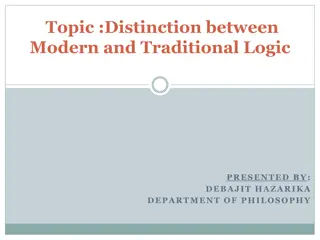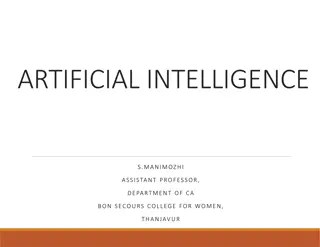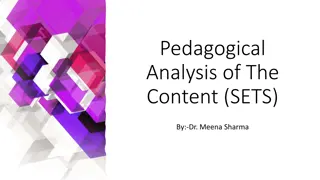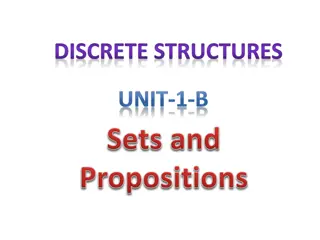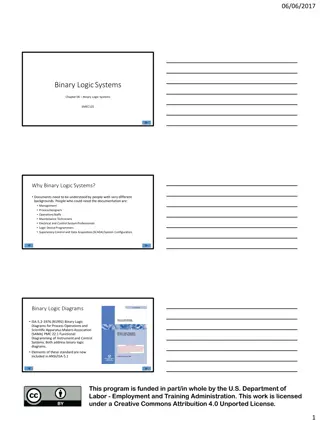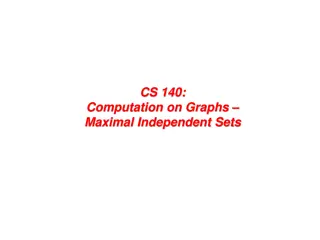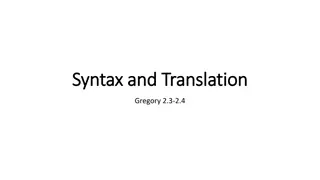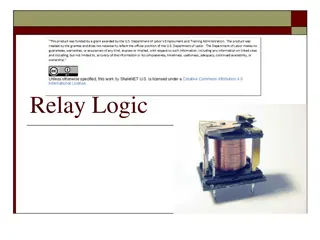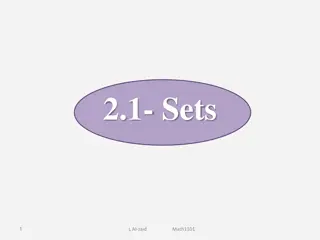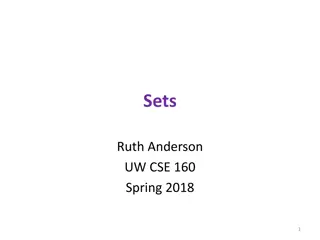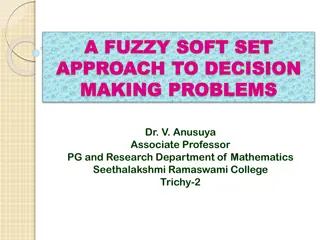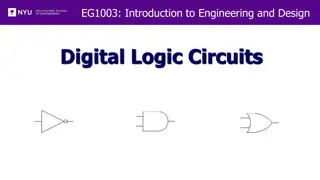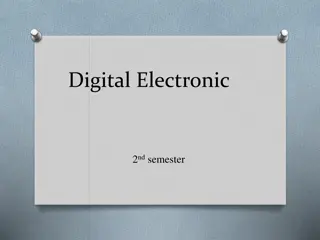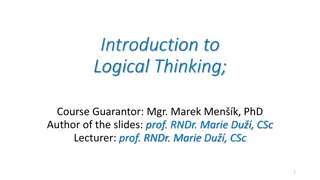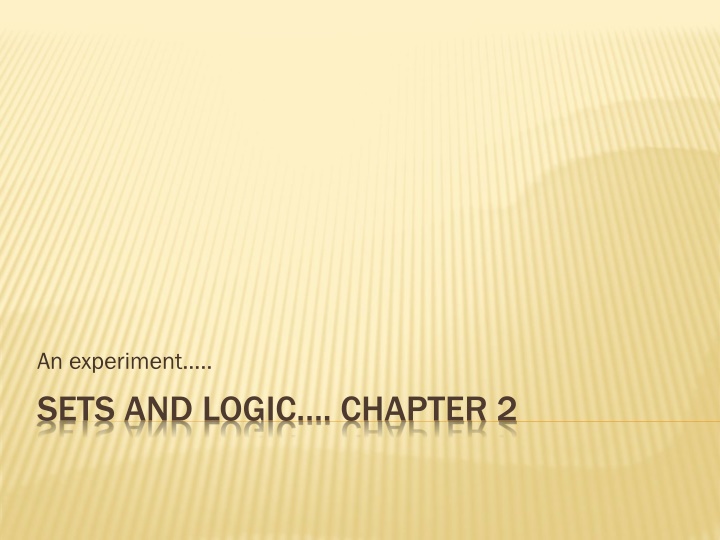
Logical Laws and Operators in Sets and Logic
Dive into Chapter 2 of "An Experiment: Sets and Logic" to explore logical laws such as DeMorgan's Laws, Commutative, Associative, and Idempotent properties, Tautologies, Contradictions, Conditional Statements, Equivalences, Converse, Contrapositive, Quantifiers, and more in the realm of Sets and Logic.
Download Presentation

Please find below an Image/Link to download the presentation.
The content on the website is provided AS IS for your information and personal use only. It may not be sold, licensed, or shared on other websites without obtaining consent from the author. If you encounter any issues during the download, it is possible that the publisher has removed the file from their server.
You are allowed to download the files provided on this website for personal or commercial use, subject to the condition that they are used lawfully. All files are the property of their respective owners.
The content on the website is provided AS IS for your information and personal use only. It may not be sold, licensed, or shared on other websites without obtaining consent from the author.
E N D
Presentation Transcript
An experiment.. SETS AND LOGIC . CHAPTER 2
LOGICAL LAWS DeMorgan s Laws ? ? ?? ?????????? ?? ? ? ?? ?????????? ?? ? ? ? ? Commutative, Associative, and Idempotent Distributive ? ? ? ?? ?????????? ?? (? ?) (? ?) ? Q ? ?? ?????????? ?? ? ? ? ? Absorption: ? ? ? ?? ?????????? ?? ? ? ? ? ?? ?????????? ?? ?
TAUTOLOGIES AND CONTRADICTIONS Statements or Formulas which are always true are Tautologies Formulas that are always false are Contradictions ? ?????????? ? ????????? ; ? ????????????? ; ? (?????????????)
VARIABLES AND SETS We will consider statements dependent upon a variable or a number of variables Ex s P(x): x is a prime number D(x,y): x is divisible by y In this case we don t have truth tables we have truth sets
CONDITIONAL STATEMENTS P implies Q: ? ? If its raining and I don t have my umbrella, then I ll get wet. If Mary did her homework, then the teacher won t collect it, and if she didn t, the he ll ask her to do it on the board
EQUIVALENCES ? ? is equivalent to ? ? ? ? is equivalent to (? ?)
THE CONVERSE AND CONTRAPOSITIVE Consider ? ? and ? ? ? ? is called the converse of ? ? ? ? is the contrapositive of ? ? The converse of ? ? is not equivalent The contrapositive is .. ? ? ?? ?????????? ?? ? ?
CHAPTER 2: QUANTIFIERS Three ideas For all or for every, we use the notation: There is one, or there exists: The universe
SEVEN OPERATORS Connectives Quantifiers ??? This is really all we need to write any mathematical statement!
NEW NOTATION ? ? > 2 ?2> 4 Is there and implied universe?
EXAMPLES ? ?2> 0 ? ?2 2? + 3 = 0 , Universe in what universe? ? ? ? ? ? , where M(x) is ( x is a man) and B(x) is ( x has brown hair ) ? ? ? ? ? ??(?,?) where L(x,y) is a like function from x to y.
WRITE AS LOGICAL STATEMENTS Someone didn t do the homework Everything in that store is either overpriced or poorly made Nobody s perfect Susan likes everyone who dislikes Joe ? ? ? ? ?\C
WRITE AS STATEMENTS Everybody in the dorm has a roommate he doesn t like Nobody likes a sore loser Anyone who has a friend who has the measles will have to be quarantined If anyone in the dorm has a friend who has the measles, then everyone in the dorm will have to be quarantined If ? ?, then A and C\B are disjoint
MULTIPLE QUANTIFIERS ? ? ? < ? ? ? ? < ? ? ? ? < ? ? ? ? < ? ? ? ? < ? ? ?(? < ?)
EQUIVALENCE INVOLVING QUANTIFIERS Quantifier Negation Laws ?? ? ?? ?????????? ?? ? ? ? ?? ? ?? ?????????? ?? ? ?(?)
EXAMPLES Negate the statements, and then reexpress the results as equivalent positive statements ? ? Everyone has a relative he doesn t like
ANALYZE THE LOGICAL FORMS All married couples have fights Everyone likes at least two people John likes exactly one person
ANAYZE THE LOGICAL FORMS Statements about the natural numbers x is a perfect square x is a multiple of y x is prime x is the smallest number that is a multiple of both y and z
ANALYZE THE STATEMENTS Statements about real numbers The identity element for addition is 0. Every real number has and additive inverse Negative numbers don t have square roots Every positive number has exactly two square roots
2.3. MORE ON SETS Instead of just ? ?(?) we can consider more general forms ?(?) ? [0,1] ??+? ??+???[0,1]
MORE EXAMPLES 3? ?? ?? ????? ? ?2?? and ?3?? are disjoint
THE POWER SET The Power Set ? = ? ? ? Find the Power Set for ? = ?,?,?
ANALYZE THE LOGICAL FORMS ?? ? ? ? ?? (?) ? ?? ? ? ?? (?) (?)
INTERSECTIONS AND UNIONS = 1,2,3,4 , 2,3,4,5}, 3,4,5,6 Find
DEFINITIONS: UNIONS AND INTERSECTIONS = ? ?? ??? = ? ?(?? ??? = ? ?? ??? = ? ?(?? ???
ANALYZE THE LOGICAL FORMS ?? G ?? ?? (?) ??
ANOTHER EXAMPLE ? = 1,2,3 ??= ?,? + 1,? + 2,? + 3 Find ?????and ?????

